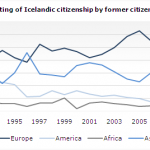 When Tiger Woods was caught having not just one but multiple and simultaneous extramarital affairs, many news sources labeled him a “sex addict.” What else could explain cheating on a gorgeous blonde Swedish swim suit model (so the reasoning went). In response to the massive negative press, Woods effectively went underground, canceling all public appearances. A few weeks later, the media storm was still raging and Woods checked himself into Pine Grove Behavioral Health & Addiction Services, a Mississippi clinic specializing in sexual addition treatment.
When Tiger Woods was caught having not just one but multiple and simultaneous extramarital affairs, many news sources labeled him a “sex addict.” What else could explain cheating on a gorgeous blonde Swedish swim suit model (so the reasoning went). In response to the massive negative press, Woods effectively went underground, canceling all public appearances. A few weeks later, the media storm was still raging and Woods checked himself into Pine Grove Behavioral Health & Addiction Services, a Mississippi clinic specializing in sexual addition treatment.
 Months later, just as Woods was attempting to re-establish his chaste public image, Jesse James, the husband of Oscar winning Sandra Bullock, was exposed as having committed similar transgressions. After being slammed by the media James too checked himself into a sex addiction clinic, the Sierra Tuscan in Tuscon Arizona. While the use of medical/ “disease” models around sexual “deviance” is not new, the recent high profile cases raise for me the following questions:
Months later, just as Woods was attempting to re-establish his chaste public image, Jesse James, the husband of Oscar winning Sandra Bullock, was exposed as having committed similar transgressions. After being slammed by the media James too checked himself into a sex addiction clinic, the Sierra Tuscan in Tuscon Arizona. While the use of medical/ “disease” models around sexual “deviance” is not new, the recent high profile cases raise for me the following questions:
- What role are sex addiction clinics playing in regulating discourses of sexuality?
- How are discourses of sex addiction intersecting with and reinforcing individualized assumptions of sin and redemption, in other words, conservative religious discourses of sexuality?
- Do sex addiction clinics serve as public (and for profit) confessional booths for “secular” society?
- What role do public confession and redemption scripts play in larger belief structures about “good” and “bad” sexuality (now labeled “healthy” and “unhealthy” sexuality)?
- In what ways do sex addiction discourses ignore practical (e.g. partners living separate lives) and systemic (imbalances of power and privilege) issues related to infidelity?
- How do major institutions (e.g. those related to religion, medicine, criminal justice, and business) benefit from avoiding the practical and systemic, focusing instead on individualistic, moral understanding of sexuality?
The mission statements of both Woods’ and James’ clinics clearly state that sex addition/compulsion is in part a medical matter. Pine Grove (where Woods was a resident) offers a special program called “Gentle Path” which refers to sexual addiction as a “disease:”
The Gentle Path Program offers gender specific treatment to aid men and women in regaining their freedom from the disease of sexual addiction. Most patients are simultaneously treated for mood disturbance, anxiety or other addictions, such as chemical dependency. The Gentle Path Program has a special focus on working through past trauma and family problems. The program is designed to help men and women regain freedom from compulsive behaviors and develop a sense of healthy sexuality.
While not specifically sponsored by any religious organization, Pine Grove emphasizes religious/spiritual aspects of healing. The “Gentle Path” program (an ironic name given its austere living requirements) requires members to sign a celibacy contract, including a promise not to masturbate during the course of their treatment. Clients are also forbidden to leave during their treatment the except for group chaperoned fieldtrips. Like many prison environments, the clinic appears to serve in part a punitive function. News reports appeared to take glee in the fact that Woods was retreating to a place that would cause him physical as as well as moral hardship:
“The world’s No. 1 golfer will not have an easy time of it as he tries to conquer the demons that led him to repeatedly cheat on his stunning wife with multiple women.” (NYDailynews.com)
In a recent article in Alternet.org, psychologist and psychoanalyst Michael Bader calls sex addiction a “B.S. excuse for not thinking.” Bader asks,
“If a married man has a lot of extramarital sex, is he necessarily a sex addict? If a seemingly straight man frequents restrooms for casual sex, is he an addict? How much pornography does someone have to look at, how many hours spent in chat rooms, hookers hired, to go from “hound dog” to “sex addict”
Bader goes on to explain the difference between drug and alcohol addiction and “sex addiction”:
“Traditional addictions like those to alcohol or heroin always involve the presence of tolerance and withdrawal; that is, increasing amounts of the substance are required to achieve the same effect, and in its absence the addict suffers an increasingly painful psychophysiological state as the body and brain rebound. But when it comes to sex addiction, physiological tolerance and withdrawal are usually not present, and if they are, they don’t govern the addict’s life in the same way that, say, opiates do. Sex addicts get anxious when they can’t get their “fix” — they don’t go into DTs.”
In fact, Bader argues, the addiction model for sexual infidelity ironically perpetuates pathological sexuality:
“… by viewing someone’s sexual desires as addictions, 12-step approaches can subtly reinforce someone’s own pathological view of themselves. People struggling with sexual compulsions are already afraid of their sexuality, viewing it as an alien internal beast. To imply that the addict’s sexual fantasies and sources of satisfaction are, like alcohol to the alcoholic, a loaded gun, reinforces this belief, when in fact it’s simply another fantasy. The actual psychological reality is that the so-called addicts’ desires and fantasies are perfectly understandable attempts to deal with anxiety and depression given the context of their personal histories, their painful and irrational views about themselves and about men and women, and their inability to imagine a healthier way of living. Once they’re helped to become aware of these meanings, they actually increase their self-compassion and are freer to exercise self-control.”
Bader concludes with an analysis that extends to many public sexual stories:
“Everywhere that sex enters the public arena, whether it be in education, gay marriage, Internet sex, or the hypocrisy of self-righteous politicians getting busted for their indiscretions, we see a worrisome refusal or inability to think about psychological meaning, and to instead reduce the conversation to either a morality play or a voyeuristic parade of gossip and speculation. Replacing the psychologically complex and intensely human drama of sexual behavior with two-dimensional labels like addiction is but one example of this trend.”
Bader’s analysis is needed in a world saturated with simplistic psycho/moral/medical discourses. This is a small but important step toward serious systemic analysis. Even the quintessential playboy, Hugh Hefner, understands this. When asked if he thinks golfer Tiger Woods can overcome his playboy transgressions, Hefner replied curtly:
“He can if he wants to. But this whole idea that it’s a sex addiction is a copout. Some people become obsessed with sex, but it’s not like an alcohol or drug addiction. He did it because he could get away with it.”
While Elin Nordegren may indeed not want her estranged husband, Tiger Woods, to “get away with it,” Woods’ treatment for sex addiction and his public confessional performance has little to do with Elin, and more to do with replicating and selling individualistic morality tales around sexuality.
———
Referenced articles
Bader, M. Jan. 19, 2010. “Sex Addiction: A B.S. Excuse for not thinking.” Alternet.
Huffington Post, April 13, 2010. “Hugh Hefner slams Tiger Woods, Jesse James, and Sex Addiction.









 January 13, 2010 – 7:00am
January 13, 2010 – 7:00am the Olympics in her hometown never came to pass.
the Olympics in her hometown never came to pass.

 However, the following year another women, Katherine Switzer, entered the race as a man and was discovered on the track by an official who, literally, tried to push her off the road due to her gendered transgression.
However, the following year another women, Katherine Switzer, entered the race as a man and was discovered on the track by an official who, literally, tried to push her off the road due to her gendered transgression.
 Similar structural and cultural analyses incorporating masculinity and institutional/political power could and should also be applied to the other stars of this story, including:
Similar structural and cultural analyses incorporating masculinity and institutional/political power could and should also be applied to the other stars of this story, including: 










 Dr. Phil was one of the first to discuss this on a national stage with a show in April 2009 called, “Scary Trends: Is your Child at Risk?” In the video promo for the show, Dr. Phil warns in his classic fatherly drawl: “There are some dangerous trends popping up in schools everywhere, and you may not even know if your children are getting involved.”
Dr. Phil was one of the first to discuss this on a national stage with a show in April 2009 called, “Scary Trends: Is your Child at Risk?” In the video promo for the show, Dr. Phil warns in his classic fatherly drawl: “There are some dangerous trends popping up in schools everywhere, and you may not even know if your children are getting involved.” sent a nude photo of herself to her boyfriend, and in retaliation when they broke up the boyfriend sent the photo to a group of younger girls. The younger girls ran with the photo, using it as a powerful social shaming tool (which of course can only work within a social context where girls’ sexuality is shameful). In an interview with
sent a nude photo of herself to her boyfriend, and in retaliation when they broke up the boyfriend sent the photo to a group of younger girls. The younger girls ran with the photo, using it as a powerful social shaming tool (which of course can only work within a social context where girls’ sexuality is shameful). In an interview with  sent a topless photo of herself to a boy crush. The boy showed the photo to a friend, who embraced the opportunity to gain social power by sharing it widely with kids in that school and neighboring schools. The following comes from a story about Hope on
sent a topless photo of herself to a boy crush. The boy showed the photo to a friend, who embraced the opportunity to gain social power by sharing it widely with kids in that school and neighboring schools. The following comes from a story about Hope on 

 NEW YORK: “President Museveni, Ethics Minister Nsaba Buturo and MP David Bahati have been linked to a shadowy religious fundamentalist group in the United States known as the ‘The Family’. …According to journalist, academic and author Jeff Sharlett, who has spent years researching on The Family, its core agenda includes fighting homosexuality and abortion, promoting free-market economics and dictatorship, an idea they once termed ‘totalitarianism for Christ’. “
NEW YORK: “President Museveni, Ethics Minister Nsaba Buturo and MP David Bahati have been linked to a shadowy religious fundamentalist group in the United States known as the ‘The Family’. …According to journalist, academic and author Jeff Sharlett, who has spent years researching on The Family, its core agenda includes fighting homosexuality and abortion, promoting free-market economics and dictatorship, an idea they once termed ‘totalitarianism for Christ’. “

 “Uganda’s new
“Uganda’s new 

